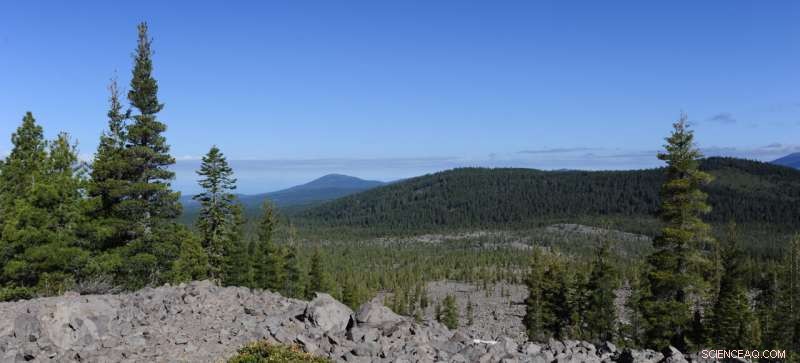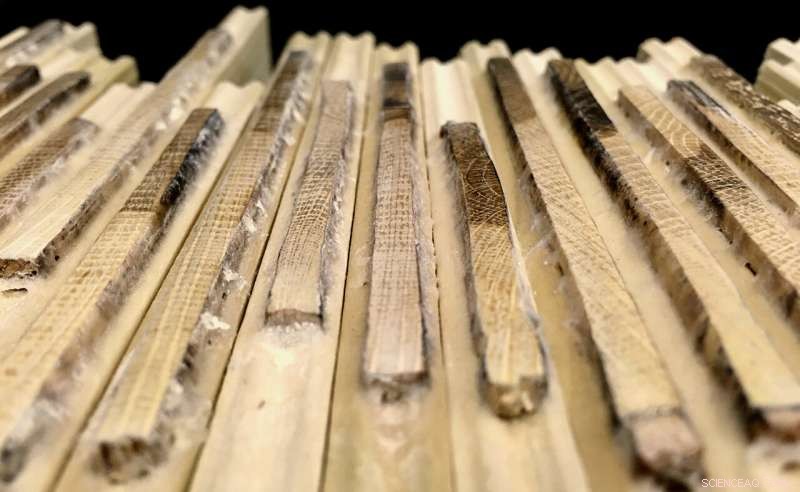
Una foresta di conifere nel nord della California. Credito:Antoine Cabon
Cosa accadrà alle foreste del mondo in un mondo che si sta riscaldando? L'aumento dell'anidride carbonica atmosferica aiuterà gli alberi a crescere? O le temperature estreme e le precipitazioni trattengono la crescita? Tutto dipende dal fatto che la crescita degli alberi sia più limitata dalla quantità di fotosintesi o dalle condizioni ambientali che influenzano la crescita delle cellule degli alberi, una domanda fondamentale nella biologia degli alberi e per la quale la risposta non è stata ben compresa fino ad ora.
Uno studio condotto dai ricercatori dell'Università dello Utah, con un team internazionale di collaboratori, rileva che la crescita degli alberi non sembra essere generalmente limitata dalla fotosintesi, ma piuttosto dalla crescita cellulare. Ciò suggerisce che dobbiamo ripensare al modo in cui prevediamo la crescita delle foreste in un clima che cambia e che le foreste in futuro potrebbero non essere in grado di assorbire tanto carbonio dall'atmosfera come pensavamo.
"Un albero che cresce è come un sistema di cavalli e carri che avanza lungo la strada", afferma William Anderegg, professore associato presso la U's School of Biological Sciences e ricercatore principale dello studio. "Ma fondamentalmente non sappiamo se la fotosintesi è il cavallo più spesso o se è l'espansione e la divisione cellulare. Questa è stata una domanda di lunga data e difficile sul campo. Ed è immensamente importante per capire come gli alberi risponderanno ai cambiamenti climatici".
Lo studio è pubblicato su Scienza .
Sorgente vs. sink
Abbiamo imparato le basi alle elementari:gli alberi producono il proprio cibo attraverso la fotosintesi, prendendo la luce solare, l'anidride carbonica e l'acqua e trasformandoli in foglie e legno.
C'è di più nella storia, però. Per convertire il carbonio ottenuto dalla fotosintesi in legno è necessario che le cellule del legno si espandano e si dividano.
Quindi gli alberi ottengono carbonio dall'atmosfera attraverso la fotosintesi. Questa è la fonte di carbonio degli alberi . Quindi spendono quel carbonio per costruire nuove celle di legno:il pozzo di carbonio dell'albero .

Anima in legno preparata per misurare la larghezza dell'anello. Credito:Antoine Cabon
Se la crescita degli alberi è limitata alla fonte, è limitata solo dalla quantità di fotosintesi che l'albero può eseguire e la crescita degli alberi sarebbe relativamente facile da prevedere in un modello matematico. Quindi l'aumento dell'anidride carbonica nell'atmosfera dovrebbe alleviare questa limitazione e consentire agli alberi di crescere di più, giusto?
Ma se invece la crescita degli alberi è limitata dall'affondamento, allora l'albero può crescere solo alla velocità con cui le sue cellule possono dividersi. Molti fattori possono influenzare direttamente sia la fotosintesi che il tasso di crescita cellulare, inclusa la temperatura e la disponibilità di acqua o sostanze nutritive. Quindi, se gli alberi hanno un limite di caduta, la simulazione della loro crescita deve includere la risposta di caduta a questi fattori.
The researchers tested that question by comparing the trees' source and sink rates at sites in North America, Europe, Japan and Australia. Measuring carbon sink rates was relatively easy—the researchers just collected samples from trees that contained records of growth. "Extracting wood cores from tree stems and measuring the width of each ring on these cores essentially lets us reconstruct past tree growth," says Antoine Cabon, a postdoctoral scholar in the School of Biological Sciences and lead author of the study.
Measuring carbon sources is tougher, but doable. Source data was measured with 78 eddy covariance towers, 30 feet tall or more, that measure carbon dioxide concentrations and wind speeds in three dimensions at the top of forest canopies, Cabon says. "Based on these measurements and some other calculations," he says, "we can estimate the total forest photosynthesis of a forest stand."
Decoupled
The researchers analyzed the data they collected, looking for evidence that tree growth and photosynthesis were processes that are linked, or coupled. They didn't find it. When photosynthesis increased or decreased, there was not a parallel increase or decrease in tree growth.
"Strong coupling between photosynthesis and tree growth would be expected in the case where tree growth is source limited," Cabon says. "The fact that we mostly observe a decoupling is our principal argument to conclude that tree growth is not source-limited."
Surprisingly, the decoupling was seen in environments across the globe. Cabon says they did expect to see some decoupling in some places, but "we did not expect to see such a widespread pattern."

Detail of a wood core with visible growth rings (more recent rings towards the left) and bark on the right. Credit:Antoine Cabon
The strength of coupling or decoupling between two processes can lie on a spectrum, so the researchers were interested in what conditions led to stronger or weaker decoupling. Fruit-bearing and flowering trees, for example, exhibited different source-sink relationships than conifers. More diversity in a forest increased coupling. Dense, covered leaf canopies decreased it.
Finally, coupling between photosynthesis and growth increased in warm and wet conditions, with the opposite also true:that in cold and dry conditions, trees are more limited by cell growth.
Cabon says that this last finding suggests that the source vs. sink issue depends on the tree's environment and climate. "This means that climate change may reshape the distribution of source and sink limitations of the world forests," he says.
A new way to look forward
The key takeaway is that vegetation models, which use mathematical equations and plant characteristics to estimate future forest growth, may need to be updated. "Virtually all these models assume that tree growth is source limited," Cabon says.
For example, he says, current vegetation models predict that forests will thrive with higher atmospheric carbon dioxide. "The fact that tree growth is often sink limited means that for many forests this may not actually happen."
That has additional implications:forests currently absorb and store about a quarter of our current carbon dioxide emissions. If forest growth slows down, so do forests' ability to take in carbon, and their ability to slow climate change.